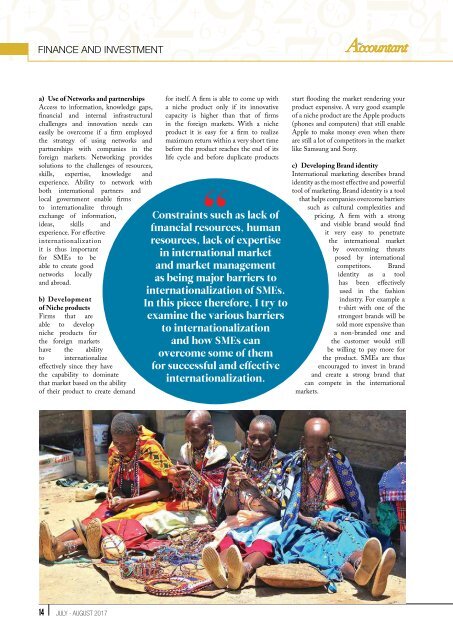The-Accountant-Jul-Aug-2017
You also want an ePaper? Increase the reach of your titles
YUMPU automatically turns print PDFs into web optimized ePapers that Google loves.
Finance and investment<br />
a) Use of Networks and partnerships<br />
Access to information, knowledge gaps,<br />
financial and internal infrastructural<br />
challenges and innovation needs can<br />
easily be overcome if a firm employed<br />
the strategy of using networks and<br />
partnerships with companies in the<br />
foreign markets. Networking provides<br />
solutions to the challenges of resources,<br />
skills, expertise, knowledge and<br />
experience. Ability to network with<br />
both international partners and<br />
local government enable firms<br />
to internationalize through<br />
exchange of information,<br />
ideas, skills and<br />
experience. For effective<br />
internationalization<br />
it is thus important<br />
for SMEs to be<br />
able to create good<br />
networks locally<br />
and abroad.<br />
b) Development<br />
of Niche products<br />
Firms that are<br />
able to develop<br />
niche products for<br />
the foreign markets<br />
have the ability<br />
to internationalize<br />
effectively since they have<br />
the capability to dominate<br />
that market based on the ability<br />
of their product to create demand<br />
for itself. A firm is able to come up with<br />
a niche product only if its innovative<br />
capacity is higher than that of firms<br />
in the foreign markets. With a niche<br />
product it is easy for a firm to realize<br />
maximum return within a very short time<br />
before the product reaches the end of its<br />
life cycle and before duplicate products<br />
Constraints such as lack of<br />
financial resources, human<br />
resources, lack of expertise<br />
in international market<br />
and market management<br />
as being major barriers to<br />
internationalization of SMEs.<br />
In this piece therefore, I try to<br />
examine the various barriers<br />
to internationalization<br />
and how SMEs can<br />
overcome some of them<br />
for successful and effective<br />
internationalization.<br />
start flooding the market rendering your<br />
product expensive. A very good example<br />
of a niche product are the Apple products<br />
(phones and computers) that still enable<br />
Apple to make money even when there<br />
are still a lot of competitors in the market<br />
like Samsung and Sony.<br />
c) Developing Brand identity<br />
International marketing describes brand<br />
identity as the most effective and powerful<br />
tool of marketing. Brand identity is a tool<br />
that helps companies overcome barriers<br />
such as cultural complexities and<br />
pricing. A firm with a strong<br />
and visible brand would find<br />
it very easy to penetrate<br />
the international market<br />
by overcoming threats<br />
posed by international<br />
competitors. Brand<br />
identity as a tool<br />
has been effectively<br />
used in the fashion<br />
industry. For example a<br />
t-shirt with one of the<br />
strongest brands will be<br />
sold more expensive than<br />
a non-branded one and<br />
the customer would still<br />
be willing to pay more for<br />
the product. SMEs are thus<br />
encouraged to invest in brand<br />
and create a strong brand that<br />
can compete in the international<br />
markets.<br />
14 JULY - AUGUST <strong>2017</strong>

















